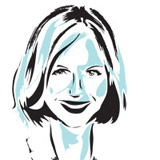Are All Museums Sex Museums?
Getting Intimate with UCSB Professor Jennifer Tyburczy's Racy Theory
Tour a museum with a mathematician, and she’ll point out the angles built into the artwork, the proportions of the figures. Tour one with a painter, and she’ll fixate on techniques, brushstrokes, and palettes. No surprise, then, that when I toured the Santa Barbara Museum of Art last week with a feminist studies professor and former bondage museum curator, well, the whole place smacked of sex.

Thought museums were sedate and sterile, did you? Take the arm of Jennifer Tyburczy, assistant UCSB professor and author of the new book Sex Museums: The Politics and Performance of Display, and you’ll discover they’re actually dirty dens of debauchery — in, like, the really good way.
Tyburczy earned her PhD while working as a curator at Chicago’s Leather Archives & Museum, a collection of galleries dedicated to fetishism and sadomasochism. But in her book, she argues that all museums—including our lovely local collection of Renoirs and Monets — are sex museums.
“Works of art mean one thing on their face,” she says, “but it’s also important where they are, who’s looking at it, and what they bring to it.”
Tyburczy is an academic at heart, tossing off phrases like “congealing into a theoretical concept and analytical category.” But when she’s looking at art? What she brings to it? Titillating stuff.
Take the ancient and innocuous-seeming Chinese earthenware sculpture “Horse with Lady Rider.” “That’s interesting because she’s not sitting sidesaddle,” Tyburczy notes. “We have this representation of Chinese femininity from the 7th century where she’s pressing her genitals to the horse, which is a huge no-no … That’s quite exciting to me.”
Then there’s Alejandro Cartagena’s “Carpoolers 20,” a bird’s-eye photo of Mexican laborers piled into the back of a pickup truck. “This image, I read it as homosocial, potentially homoerotic,” she says, arguing that the men are living in close quarters and, you know. “Some of them may be queer, some may be trans, right? We can’t always assume.” Soon she’s offering a history of anti-sodomy laws, and small groups of gallery strollers are snapping their heads around to hear her.
“This one’s kinda hot,” she purrs, sidling up beside Eugène Delacroix’s 19th-century oil painting “The Last Words of Marcus Aurelius.” “I mean, ohh, yeahhh. All the men gathered around the bed of this really ripped Marcus, the dying emperor, who still looks really gorgeous? It looks like he might have an earring. And the way he’s holding his muscles! I find this to be an erotic piece, definitely — eroticism between men, which would be completely germane to the time period. This is during the time of, like, Caligula! It was entirely possible,” she breaks into a stage whisper, “that they were all having sex!”
She teaches me the difference between nude and, well, nekkid. “Nudes are gonna be the arching of the back, the bared breast, the look,” she says, striking a coy, come-hither stance. “Very pinup girl. It’s about hailing the possessor.”
She talks a lot about this look — “the gaze” — but sometimes I think she’s saying “the gays.” I’m confused. I’m flummoxed, too, when academia comes marching off her tongue. When she speaks of “exposing the heteronormativity of museums and then dealing with ethically fraught objects in queer cultures” … I blink. She waits patiently. I blink.
In the end, though, she tells me plainly that hunting for sexual cues where you’d least expect to find them isn’t a pastime she invented.
“In a sense,” she says, “I’m paying homage to a long history of savvy queers who’ve always navigated the dominant space looking for clues as to where they can access eroticism, or be accepted, or find lovers, or friends and community.”
And suddenly I get it. Titillation aside, it’s an invaluable exercise to adjust one’s gaze from time to time (not one’s gays — they’re great) and see things from another perspective — within a different set of frames, so to speak. It’s refreshing. Informative. Eye-opening.
It’ll be a long time before I ride sidesaddle through a museum again.
Starshine Roshell is the author of Broad Assumptions.



